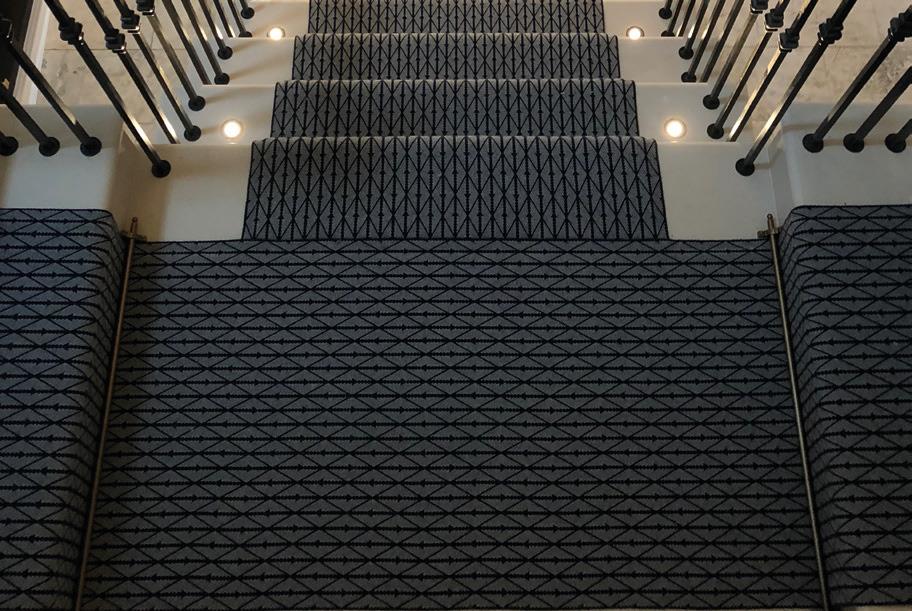
7 minute read
DECISIONS, DECISIONS…
Richard Bromell ASFAV, Charterhouse Auctioneers
As you would expect, items come into our salerooms in all shapes and sizes on our regular free valuation days. They arrive on foot, by bicycle, in vans and in the back of cars.
Advertisement
Perhaps the most memorable bit of packaging I’ve seen containing a lot was some twenty years ago. The owner walked into reception with a plastic carrier bag. It was a nice Harrods bag, and inside the bag was an old sock. In the sock was a pocket watch. The owner agreed to auction the pocket watch which went on to sell for a staggering £25,000, although quite whatever happened to the old sock and carrier bag I cannot remember!
The pocket watch was relatively straightforward – a single item of high value. Sometimes collections are brought in for valuation and sale and these can need more thought as to how best to lot and sell them.
Straight after the Christmas break, I was invited to Devon to look at a vast collection of stamps. It took several hours on the first visit to look through all the albums and the owner was kind enough to keep me topped up with coffee. It was quite a task and to give you some sort of idea of the quantity, there were over 100 Penny Blacks. Many of these will be sold individually and maybe some in twos so the collection will need to be carefully split – there are simply too many stamps and with them all being worth towards £30,000, the number of stamp collectors looking to buy such a large collection as a single lot is unlikely.
Recently though, a chap brought some automobilia over from near Bridport for some help and advice. It has been collected by his late father, mostly back in the 1920s and 1930s. There were several car brochures, black and white photographs of cars racing at Brooklands, and a collection of carrelated enamel pin badges – it was these that grabbed my attention.
Given away as marketing trinkets 90-100 years ago they are just the sort of items which were easily and readily thrown away, but his father kept them all. Over time, he amassed over 100 of these little pins and built a case to display them.
As the owner had decided to let someone new enjoy his late father’s automobilia, I discussed the best way to auction the enamel pins. Should they be sold in smaller sets or as one lot?
It might seem a relatively straightforward decision, but the pins were not collected at the same time, unlike a pair of candlesticks which would have spent all their life together. In addition, with so many motoring brands on offer would a Maserati collector also want a Mercedes-Benz pin?
However, on this occasion, and unlike the Devon stamp collection, I recommended the pins remain as a collection as they are presented as such a fabulous display.
Now entered into our April specialist auction of automobilia, they are estimated at £1,000. Hopefully the next owner will also keep the collection intact.
Niwaki
Words Claire Bowman
Photography Katharine Davies
Ireckon that gardens, like sock drawers, reflect their owners,’ says topiary guru Jake Hobson, nodding to a bag of compost in one of the raised beds where he grows Japanese veg. ‘Well, I’ve no problem with a messy garden. I’m not a nurturer or a cultivator – I’m a shaper. Big organic shapes and strong gestures are my things.’ Looking out across Jake’s masterfully designed Japanese garden it is clear what he means. Every shrub and tree (or niwaki to give ‘garden trees’ their Japanese name) has been trained, pruned and clipped to form a bold, architectural shape. From Phillyrea cloud trees and towering multi-trunked Japanese conifers to mounds of Buxus that have been clipped into soft, interlocking hills, this topiary is unlike anything you’d expect to see in a Dorset back garden. And it clearly requires patience. >
Jake’s wave hedge, for example, has taken five years of gentle clipping and coaxing to grow from small transplanted parterre hedging into a horticultural take on Hokusai Katsushika’s Great Wave. ‘It took a year to properly take root, a couple of years to get the basic shape, starting as crenellations, and now it’s finally at a point where it looks as it should,’ says Jake. ‘The trick with clipping Buxus sempervirens is to work as quickly, smoothly and rhythmically as you can. You need to keep contact with the surface, just like when plastering a wall.’
It’s that same dedication that goes into encouraging a single branch of Pinus thunbergii (black pine) to grow along a bamboo pole. ‘There’s a big tradition in Japan of training a branch over a rock or waterfall or just a patch of gravel,’ explains Jake, who has a couple of these ethereal forms dotted around his garden. ‘When I first went to Japan, I really related to these random branches, some of which grow longer than the tree is tall.’
For those all-important quiet, contemplative moments, Jake has a shingle-clad shed at the bottom of the garden, where he can enjoy a morning coffee on the veranda. ‘When we moved here 11 years ago there were originally five sheds, but I saved the old windows from one and repurposed them. I’ve planted a Japanese pear next to it and it’s surrounded by messy hazels that make this area feel like a little woodland.’
From whatever angle you view the garden, there’s no question that it makes for a beguiling scene. ‘By repeating the same shapes at the front and back you create a sense that the garden is much bigger than it actually is – it condenses it, in the same way as when you see mountains from afar,’ explains Jake. ‘Japanese gardens are about creating a sense of scale through plants – it’s that very Japanese idea that you wander through a landscape.’
A graduate of The Slade where he studied sculpture, Jake has led the way in Japanese topiary for more than 30 years, having first been introduced to it when he visited Japan on a travel award after his degree. ‘I had a return ticket for a month and my brief was to investigate the annual celebration of the cherry blossom season, hanami. The problem was that when I got to Osaka in March it was too early for the cherry blossom, so I travelled around the country visiting a lot of gardens and really got into them from a sculptural and a landscape point of view. I was fascinated by why their trees looked so different from ours.’
Once back in the UK, Jake started reading up on the history of Japanese gardening, and after doing a TEFL course and teaching English for nine months in London, where he met his future wife Keiko, the couple returned to Japan where Jake took up a position in a traditional tree nursery near Keiko’s family home in rural Osaka. ‘I was introduced to every aspect of Japanese gardening, so when we eventually moved back to England and I got a job at Architectural Plants in West Sussex, I was able to draw on that knowledge and hone my pruning skills on the nursery stock. I then approached Anna Mumford at Timber Press and went on to write two books on the subject, The Art of Creative Pruning and Niwaki: Pruning, Training and Shaping Trees the Japanese Way, both of which are still popular worldwide today.’
And then came Niwaki – Jake’s Japanese garden tool brand that now sells to discerning gardeners across the world, as well as through its store in Marylebone, >
London and HQ showroom at Chaldicott Barns, just outside Shaftesbury. It was the obvious next step for a man who couldn’t be without his secateurs. ‘Everyone kept asking me, “Oh, they’re amazing, where can I get them?”, and I’d have to say, “You can’t – they’re from Japan.” After a couple of years, I thought, “Hang on, that’s a silly answer,” so I changed it to “I’ll get you some.”
With a catalogue packed full of beautifully forged tools, from Taira Ueki scissors and Tobisho shears, to the famously safe Niwaki tripod ladder, I wonder where on earth to start. ‘The tools of the trade are a pair of shears for the big stuff and a pair of hand clippers for the detailed stuff,’ he says. ‘But we have a huge range of tools, each one incredibly well made by Japanese makers with a long tradition of working with steel.
‘The Japanese approach is to work to a desired quality rather than a price. They’ll think – how can we make a pair of secateurs really well? And then –how much are they going to cost? That’s the basic fundamental shift – it’s what English manufacturing used to be. A lot of our blacksmiths started around the mid 20th century or earlier, and from there went into garden tools, kitchen knives or industrial tools. They are typically third-generation businesses with the owner’s wife or daughter taking the orders over the phone and the grandmother packaging it all up.’
As with most things, the key to a tool’s prolonged lifespan is regular maintenance. ‘The old Japanese sushi chefs will have sliced fish every day for 50 years and their knives will be really narrow because they’ll have cleaned and sharpened them every night since they began,’ says Jake, showing me a ‘little magic trick’ of how he removes rust and grime from a pair of shears with water and a scouring block. ‘In the summer I’ll clean my shears every time I use them. It’s a little bit of a symbiotic relationship between me and my garden tools. They might be interchangeable, but you do kind of get to know each one. If you continue to keep them clean and cherish them, they’ll grow with you.’ niwaki.com
With a little luck, the right tools and a lot of patience, you can be creating beautiful niwaki in a quiet corner of your own.
The Niwaki Showroom, 7 Chaldicott Barns, Semley SP7 9AW is open Monday - Friday 10am to 4pm and Saturday 10am to 2pm.
Preparing for a greener spring





Save water
You can reduce waste by collecting rainfall with water butts and soak up even more rainwater by improving the soil before sealing the moisture in with a layer of mulch on top.
Care for wildlife
Increasing the diversity of your planting will attract more wildlife, while water stations, nesting boxes and bug hotels will help look after any new visitors.



Improve the soil
By incorporating organic matter, the soil will have a better structure which improves drainage and creates a more fertile environment in which your plants can grow.
More composting
Compost bins are an ideal way to produce your own soil improver. Keeping the material in your own garden is also environmentally sound.



At Bill Butters Windows Ltd we offer total window, door and conservatory solutions. Based in Sherborne we design, manufacture, supply and install high quality aluminium and uPVC products using market leading suppliers to service both the retail and commercial sectors.


For more information visit our website or come down to the showroom.










